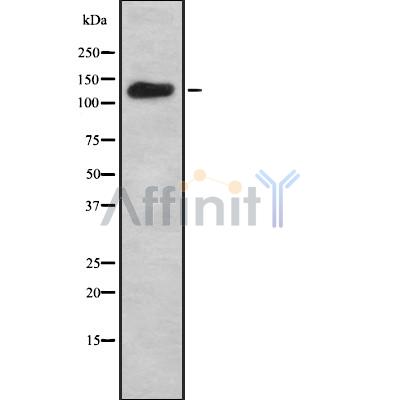ADCY7 Antibody - #DF8917
| Product: | ADCY7 Antibody |
| Catalog: | DF8917 |
| Description: | Rabbit polyclonal antibody to ADCY7 |
| Application: | WB IHC |
| Reactivity: | Human, Mouse, Rat |
| Prediction: | Pig, Dog |
| Mol.Wt.: | 120 kDa; 120kD(Calculated). |
| Uniprot: | P51828 |
| RRID: | AB_2842113 |
Product Info
*The optimal dilutions should be determined by the end user. For optimal experimental results, antibody reuse is not recommended.
*Tips:
WB: For western blot detection of denatured protein samples. IHC: For immunohistochemical detection of paraffin sections (IHC-p) or frozen sections (IHC-f) of tissue samples. IF/ICC: For immunofluorescence detection of cell samples. ELISA(peptide): For ELISA detection of antigenic peptide.
Cite Format: Affinity Biosciences Cat# DF8917, RRID:AB_2842113.
Fold/Unfold
adenylate cyclase 7; adenylyl cyclase; ATP pyrophosphate-lyase; KIAA0037;
Immunogens
A synthesized peptide derived from human ADCY7, corresponding to a region within the internal amino acids.
- P51828 ADCY7_HUMAN:
- Protein BLAST With
- NCBI/
- ExPASy/
- Uniprot
MPAKGRYFLNEGEEGPDQDALYEKYQLTSQHGPLLLTLLLVAATACVALIIIAFSQGDPSRHQAILGMAFLVLAVFAALSVLMYVECLLRRWLRALALLTWACLVALGYVLVFDAWTKAACAWEQVPFFLFIVFVVYTLLPFSMRGAVAVGAVSTASHLLVLGSLMGGFTTPSVRVGLQLLANAVIFLCGNLTGAFHKHQMQDASRDLFTYTVKCIQIRRKLRIEKRQQENLLLSVLPAHISMGMKLAIIERLKEHGDRRCMPDNNFHSLYVKRHQNVSILYADIVGFTQLASDCSPKELVVVLNELFGKFDQIAKANECMRIKILGDCYYCVSGLPVSLPTHARNCVKMGLDMCQAIKQVREATGVDINMRVGIHSGNVLCGVIGLRKWQYDVWSHDVSLANRMEAAGVPGRVHITEATLKHLDKAYEVEDGHGQQRDPYLKEMNIRTYLVIDPRSQQPPPPSQHLPRPKGDAALKMRASVRMTRYLESWGAARPFAHLNHRESVSSGETHVPNGRRPKSVPQRHRRTPDRSMSPKGRSEDDSYDDEMLSAIEGLSSTRPCCSKSDDFYTFGSIFLEKGFEREYRLAPIPRARHDFACASLIFVCILLVHVLLMPRTAALGVSFGLVACVLGLVLGLCFATKFSRCCPARGTLCTISERVETQPLLRLTLAVLTIGSLLTVAIINLPLMPFQVPELPVGNETGLLAASSKTRALCEPLPYYTCSCVLGFIACSVFLRMSLEPKVVLLTVALVAYLVLFNLSPCWQWDCCGQGLGNLTKPNGTTSGTPSCSWKDLKTMTNFYLVLFYITLLTLSRQIDYYCRLDCLWKKKFKKEHEEFETMENVNRLLLENVLPAHVAAHFIGDKLNEDWYHQSYDCVCVMFASVPDFKVFYTECDVNKEGLECLRLLNEIIADFDELLLKPKFSGVEKIKTIGSTYMAAAGLSVASGHENQELERQHAHIGVMVEFSIALMSKLDGINRHSFNSFRLRVGINHGPVIAGVIGARKPQYDIWGNTVNVASRMESTGELGKIQVTEETCTILQGLGYSCECRGLINVKGKGELRTYFVCTDTAKFQGLGLN
Predictions
Score>80(red) has high confidence and is suggested to be used for WB detection. *The prediction model is mainly based on the alignment of immunogen sequences, the results are for reference only, not as the basis of quality assurance.
High(score>80) Medium(80>score>50) Low(score<50) No confidence
Research Backgrounds
Catalyzes the formation of cAMP in response to activation of G protein-coupled receptors (Probable). Functions in signaling cascades activated namely by thrombin and sphingosine 1-phosphate and mediates regulation of cAMP synthesis through synergistic action of the stimulatory G alpha protein with GNA13. Also, during inflammation, mediates zymosan-induced increase intracellular cAMP, leading to protein kinase A pathway activation in order to modulate innate immune responses through heterotrimeric G proteins G(12/13) (By similarity). Functions in signaling cascades activated namely by dopamine and C5 alpha chain and mediates regulation of cAMP synthesis through synergistic action of the stimulatory G protein with G beta:gamma complex. Functions, through cAMP response regulation, to keep inflammation under control during bacterial infection by sensing the presence of serum factors, such as the bioactive lysophospholipid (LPA) that regulate LPS-induced TNF-alpha production. However, it is also required for the optimal functions of B and T cells during adaptive immune responses by regulating cAMP synthesis in both B and T cells (By similarity).
Phosphorylated by PRKCD.
Membrane>Multi-pass membrane protein.
The protein contains two modules with six transmembrane helices each; both are required for catalytic activity. Isolated N-terminal or C-terminal guanylate cyclase domains have no catalytic activity, but when they are brought together, enzyme activity is restored. The active site is at the interface of the two domains. Both contribute substrate-binding residues, but the catalytic metal ions are bound exclusively via the N-terminal guanylate cyclase domain.
Belongs to the adenylyl cyclase class-4/guanylyl cyclase family.
Research Fields
· Cellular Processes > Cell growth and death > Oocyte meiosis. (View pathway)
· Cellular Processes > Cellular community - eukaryotes > Gap junction. (View pathway)
· Environmental Information Processing > Signal transduction > Rap1 signaling pathway. (View pathway)
· Environmental Information Processing > Signal transduction > Calcium signaling pathway. (View pathway)
· Environmental Information Processing > Signal transduction > cGMP-PKG signaling pathway. (View pathway)
· Environmental Information Processing > Signal transduction > cAMP signaling pathway. (View pathway)
· Environmental Information Processing > Signal transduction > Phospholipase D signaling pathway. (View pathway)
· Environmental Information Processing > Signal transduction > Apelin signaling pathway. (View pathway)
· Human Diseases > Drug resistance: Antineoplastic > Endocrine resistance.
· Human Diseases > Substance dependence > Morphine addiction.
· Human Diseases > Infectious diseases: Viral > HTLV-I infection.
· Human Diseases > Cancers: Overview > Pathways in cancer. (View pathway)
· Human Diseases > Cardiovascular diseases > Dilated cardiomyopathy (DCM).
· Metabolism > Nucleotide metabolism > Purine metabolism.
· Organismal Systems > Immune system > Chemokine signaling pathway. (View pathway)
· Organismal Systems > Aging > Longevity regulating pathway. (View pathway)
· Organismal Systems > Aging > Longevity regulating pathway - multiple species. (View pathway)
· Organismal Systems > Circulatory system > Adrenergic signaling in cardiomyocytes. (View pathway)
· Organismal Systems > Circulatory system > Vascular smooth muscle contraction. (View pathway)
· Organismal Systems > Immune system > Platelet activation. (View pathway)
· Organismal Systems > Environmental adaptation > Circadian entrainment.
· Organismal Systems > Nervous system > Retrograde endocannabinoid signaling. (View pathway)
· Organismal Systems > Nervous system > Glutamatergic synapse.
· Organismal Systems > Nervous system > Cholinergic synapse.
· Organismal Systems > Nervous system > GABAergic synapse.
· Organismal Systems > Sensory system > Inflammatory mediator regulation of TRP channels. (View pathway)
· Organismal Systems > Endocrine system > Insulin secretion. (View pathway)
· Organismal Systems > Endocrine system > Ovarian steroidogenesis.
· Organismal Systems > Endocrine system > Progesterone-mediated oocyte maturation.
· Organismal Systems > Endocrine system > Estrogen signaling pathway. (View pathway)
· Organismal Systems > Endocrine system > Melanogenesis.
· Organismal Systems > Endocrine system > Thyroid hormone synthesis.
· Organismal Systems > Endocrine system > Oxytocin signaling pathway.
· Organismal Systems > Endocrine system > Regulation of lipolysis in adipocytes.
· Organismal Systems > Endocrine system > Aldosterone synthesis and secretion.
· Organismal Systems > Endocrine system > Relaxin signaling pathway.
· Organismal Systems > Digestive system > Salivary secretion.
· Organismal Systems > Digestive system > Gastric acid secretion.
· Organismal Systems > Digestive system > Pancreatic secretion.
Restrictive clause
Affinity Biosciences tests all products strictly. Citations are provided as a resource for additional applications that have not been validated by Affinity Biosciences. Please choose the appropriate format for each application and consult Materials and Methods sections for additional details about the use of any product in these publications.
For Research Use Only.
Not for use in diagnostic or therapeutic procedures. Not for resale. Not for distribution without written consent. Affinity Biosciences will not be held responsible for patent infringement or other violations that may occur with the use of our products. Affinity Biosciences, Affinity Biosciences Logo and all other trademarks are the property of Affinity Biosciences LTD.
